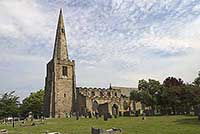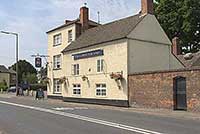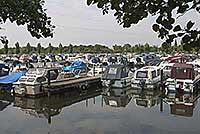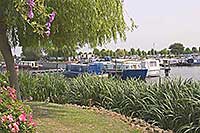Sawley
Sawley in Derbyshire
Sawley village is situated in South Derbyshire close to Long Eaton and both the river Trent and Trent and Mersey canal. Up until the 19th century, Sawley was the most important village in the area, an extensive ecclesiastical parish, which included Breaston, Draycott, Hopwell, Long Eaton, Risley, Wilne and Wilsthorpe.
The old English name for Sawley village was Sallé, meaning "hill where willow trees grow" and the early development of the village was due to its command of a river crossing. For many years however, before Harrington Bridge was built in 1790, travellers had to cross the River Trent either by ferry or by ford. Harrington bridge was a toll bridge, and charges were levied on all except the Lord of the Manor, his servants and the inhabitants of Sawley and Hemington. The bridge continues to be an important river crossing and still retains part of the original 18th century structure.

Sawley church |

Sawley pub |

Sawley Marina |

Sawley Marina |
The first settlement of Sawley around the church of All Saints was built on rising ground above the normal flood plain of the River Trent. A ford across the river shallows to the west of the Harrington Bridge was lost following the creation of the weir near Redhill in 1792. The basic layout of the village, including its twitchells, still exists today.
Until the expansion of Long Eaton, the district was mainly agricultural and although there was stocking-making in the village before 1680, it never became an extensive occupation. Many people from Sawley worked in the mills at Wilne, which were spinning cotton by water power towards the end of the 18th century and people from both Long Eaton and Sawley worked on the waterways.
During the late 18th and early 19th centuries, Sawley was the centre for boat-building, and there were many warehouses for this purpose, situated around Trent Lock. Boating still plays a large part of village life with the Sawley Marina. The River Trent is accessed from the Marina via the flood controlled Sawley Cut built in the late 18th century. With a site of 26 acres, 23 acres of which is water, and 600 moorings Sawley Marina is one the largest on the inland waterways in the country and used by both cruisers and narrowboats.
Sawley church of All Saints, dates from the 13th century, with Saxon and possibly Norman work. The embattled stone screen behind the altar is exceptional, and probably enclosed a vestry. The most notable features of the church are the restored mediaeval stalls in the chancel, monuments to the Bothe family including an alibaster effigy and tomb of John Boothe, treasurer of Lichfield cathedral who died in 1496, and a fine pulpit dating from 1636. The tower and spire date from the 15th century. Every year around the August Bank Holiday, Sawley All Saints holds a flower festival, with themed floral displays inside the church.
Throughout the whole of the 19th century, there were two principle land owners. The Earl of Harrington and William Bennett.
Opposite Sawley church is Bothe Hall, which stands in its own grounds. The building was probably built between 1660 and 1680, and has an interior that contains some exposed ceiling beams and a regency staircase. Other buildings of interest in the area include Church Farm, which stands on its ancient site, and the Sawley Baptist Church, which was built in 1800.
There are three long-established public houses in Sawley - the Nags Head, The White Lion, and the Harrington Arms. These were first developed as hostelries to serve coaches travelling through the village.